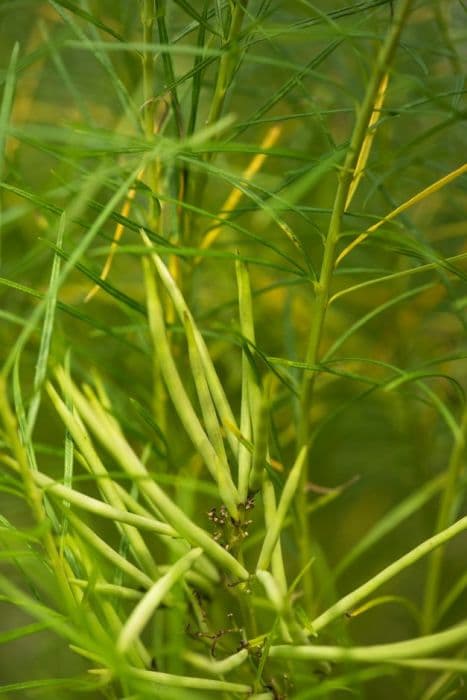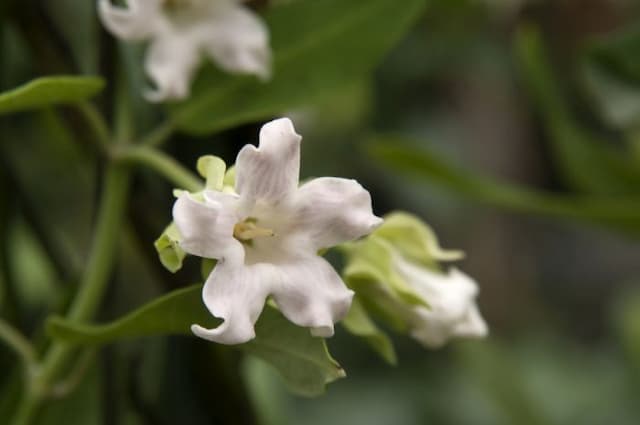String of Hearts Ceropegia linearis subsp. woodii

ABOUT
The plant commonly known as String of Hearts is celebrated for its eye-catching and delicate appearance. It possesses slender, trailing stems, from which heart-shaped leaves artfully dangle. The leaves themselves are quite distinctive – they are variegated with a pattern that includes shades of green, silver, and sometimes pink. Moreover, the underside of these leaves often exhibits a beautiful purplish hue, adding to its overall charm. As for the flowers, they are just as unique, resembling small, intricate lanterns. They typically come in shades of pale magenta to dark purple, often with a tubular shape that twists at the end. The String of Hearts creates a cascade of color and texture, making it particularly well-suited for hanging baskets or elevated planters where its trailing vines can gracefully spill over the edges, creating a natural tapestry of foliage and blooms. This decorative quality has made it a favorite among indoor plant enthusiasts, adding a touch of romance and whimsy to any space it adorns.
About this plant
 Names
NamesFamily
Apocynaceae
Synonyms
String of Hearts, Chain of Hearts, Rosary Vine, Hearts on a String, Sweetheart Vine, Heart-Leaf Vine, Collar of Hearts
Common names
Ceropegia woodii, Ceropegia barbertonensis, Ceropegia euryacme, Ceropegia hastata, Ceropegia schoenlandii, Ceropegia linearis.
 Toxicity
ToxicityTo humans
The String of Hearts is generally considered non-toxic to humans. Ingesting parts of the plant typically does not cause poisoning or serious symptoms. However, as with any non-food plant, if large amounts are ingested it might cause mild stomach discomfort.
To pets
String of Hearts is also considered non-toxic to pets, including cats and dogs. Similar to humans, ingestion of this plant is not expected to lead to significant symptoms of poisoning. Nonetheless, it is always prudent to prevent pets from chewing on houseplants as a precautionary measure, and any consumption could potentially cause mild gastrointestinal upset.
 Characteristics
CharacteristicsLife cycle
Perennials
Foliage type
Evergreen
Color of leaves
Variegated
Flower color
Mixed
Height
2 inches (5 cm)
Spread
4 feet (1.2 meters)
Plant type
Climber
Hardiness zones
10
Native area
South Africa
Benefits
 General Benefits
General Benefits- Aesthetic Appeal: Ceropegia woodii, commonly known as String of Hearts, has a unique and ornamental appearance with heart-shaped leaves and trailing vines that make it popular for indoor decoration.
- Low Maintenance: The plant is well-suited for busy individuals as it requires minimal care, being drought-tolerant and capable of thriving in a variety of indoor conditions.
- Easy Propagation: String of Hearts can be easily propagated from cuttings, which allows for easy sharing and multiplication of the plant.
- Long Lifespan: With proper care, the String of Hearts can be a long-lived plant, providing years of enjoyment.
- Space Efficient: Due to its trailing nature, Ceropegia woodii is an ideal plant for small spaces and for hanging planters, maximizing vertical space.
 Medical Properties
Medical PropertiesThis plant is not used for medical purposes.
 Air-purifying Qualities
Air-purifying QualitiesThis plant is not specifically known for air purifying qualities.
 Other Uses
Other Uses- Ceropegia woodii can be used as a living curtain when grown on a trellis to lightly screen and enhance privacy in small areas or apartments.
- The vines and heart-shaped leaves of this plant are popular in creating intricate indoor topiaries, adding artistic greenery to home decor.
- It makes an excellent addition to a fairy garden due to its delicate and trailing growth habit, creating a whimsical atmosphere.
- Used in hanging basket arrangements, Ceropegia woodii's cascading vines offer an aesthetic feature in balcony and patio design.
- The plant's tubers, which resemble potatoes, are employed in creating educational activities about plant growth and tuber formation for children and students.
- During festive times, its strings of heart-shaped leaves are utilized as a natural and living alternative to traditional decorations.
- The plant is a popular choice for creating bridal bouquets and table centerpieces on weddings due to its elegant and semi-succulent foliage.
- In art, Ceropegia woodii is sometimes used as inspiration or as part of mixed media installations because of its unique growth pattern and aesthetic appeal.
- Its resilient nature allows it to be used in theatrical and film set designs as a prop that can withstand the stresses of the production environment.
- The plant's distinctive appearance lends itself to being a subject for botanical illustration and photography, fostering an appreciation for natural forms and structures.
Interesting Facts
 Feng Shui
Feng ShuiThe String of Hearts is not used in Feng Shui practice.
 Zodiac Sign Compitability
Zodiac Sign CompitabilityThe String of Hearts is not used in astrology practice.
 Plant Symbolism
Plant Symbolism- Enduring Love - The plant's heart-shaped leaves and the resilience with which it grows signify a love that endures through challenges.
- Eternal Connection - Known as String of Hearts, this vine's long trailing stems symbolize people's connections that go on indefinitely, mirroring how the plant spreads.
- Independence - As a hardy succulent, the String of Hearts represents the ability to thrive independently, needing very little to prosper.
 Water
WaterThe String of Hearts (Ceropegia linearis subsp. woodii) should be watered approximately once every week to ten days, allowing the soil to dry out between waterings. It's advisable to use the soak and dry method, watering the plant thoroughly until excess water drains out, without leaving the pot in standing water. As a succulent, it's very drought-tolerant, so it's better to underwater than overwater. During active growth in spring and summer, you may need to water more frequently, while in the cooler, dormant months, you can reduce watering to once every two or three weeks. Typically, about 8-16 ounces of water per watering should suffice, depending on the size of the pot and the environment's humidity levels.
 Light
LightThe String of Hearts prefers bright, indirect light to flourish but can tolerate some direct sunlight, especially if it's the soft morning light. A spot near a north or east-facing window would be ideal, where it can receive plenty of light without the harsh intensity of the midday sun. However, too much direct sunlight can scorch its delicate leaves, so care should be taken to avoid placing it in a south-facing window without any shade during the peak afternoon hours.
 Temperature
TemperatureThe String of Hearts thrives in temperature conditions between 60 and 80 degrees Fahrenheit. It can survive in temperatures as low as 40 degrees, but growth will slow down considerably. It's important to protect the plant from temperatures below 40 degrees, as it can suffer damage from frost. The ideal temperature range for this plant's healthy growth is around the 70s Fahrenheit, providing a warm environment without being too hot or too cold.
 Pruning
PruningPruning the String of Hearts is mainly done to maintain its shape, encourage fuller growth, or remove dead or damaged vines. The best time to prune is in the spring before new growth begins. It doesn't need frequent pruning; once or twice a year is usually sufficient. Always use clean, sharp scissors to make precise cuts, and you can propagate the cuttings if desired to create new plants.
 Cleaning
CleaningAs needed
 Soil
SoilString of Hearts prefers a well-draining potting mix composed of part potting soil, part perlite or pumice for aeration, and part orchid bark for added drainage. The best pH range for this plant is slightly acidic to neutral, around 6.0 to 7.5.
 Repotting
RepottingString of Hearts should be repotted every couple of years or when the plant has outgrown its current pot to encourage growth and refresh the soil. It's best to repot in spring or early summer.
 Humidity & Misting
Humidity & MistingString of Hearts thrives in average household humidity levels, but can benefit from slightly higher humidity; aiming for 40-50% humidity is ideal for this plant.
 Suitable locations
Suitable locationsIndoor
Place in bright, indirect light and water sparingly.
Outdoor
Hang in partial shade, protect from cold, water moderately.
Hardiness zone
10-12 USDA
 Life cycle
Life cycleThe life of Ceropegia woodii, commonly known as String of Hearts, begins with seed germination where warmth, light, and moisture trigger the development of the plant from a seed. Following germination, seedlings establish themselves, developing a system of vines and heart-shaped leaves characteristic of this species. As it matures, the plant exhibits rapid vine growth under ideal conditions of bright, indirect light and well-draining soil. During its growth phase, the String of Hearts may produce tubers on its vines, which can fall to the soil and grow into new plants. This plant flowers intermittently throughout the year, producing small, lantern-shaped flowers that are pollinated by flies attracted to their unique structure and scent. After pollination and seed set, the life cycle can continue if seeds disperse and find suitable conditions for germination, repeating the process of growth and reproduction.
 Propogation
PropogationPropogation time
Spring-Summer
Propogation: The most popular method of propagating String of Hearts, or Ceropegia linearis subsp. woodii, is through stem cuttings, particularly in spring or summer when the plant is in its active growth phase. To do this, take a healthy stem of about 4 to 6 inches long (approximately 10 to 15 centimeters) that includes several leaves. Allow the cut end to callous over for a few hours or overnight to prevent rot. Plant the cutting in a well-draining potting mix, ensuring that the nodes (where the leaves meet the stem) are buried, as these are where roots will develop. Water the soil lightly but consistently, keeping it moist but not soggy, to encourage rooting. In a few weeks, the cutting should establish roots, allowing it to grow into a new String of Hearts plant.









